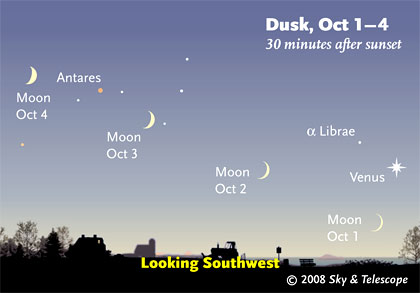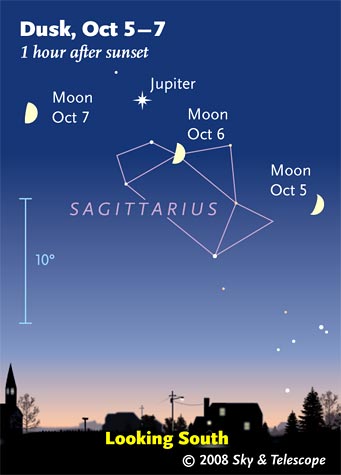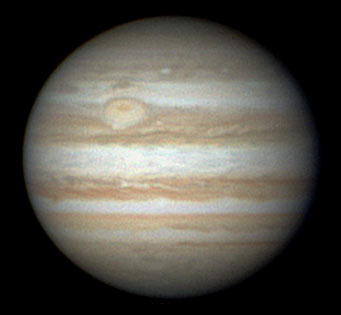Some daily events in the changing sky for October 3 – 11.

Watch the Moon wax in the west from night to night, passing Venus and fainter Antares. (These scenes are drawn for the middle of North America. European observers: move each Moon symbol a quarter of the way toward the one for the previous date. For clarity, the Moon is shown three times actual size.)
Sky & Telescope diagram
Friday, October 3
Saturday, October 4
Sunday, October 5

As the Moon waxes through the week, watch it pass Jupiter and the Sagittarius Teapot. (The blue10° scale is about the size of your fist held at arm's length).
Alan MacRobert
Monday, October 6
Tuesday, October 7
Wednesday, October 8
Thursday, October 9
Friday, October 10
Saturday, October 11
Want to become a better amateur astronomer? Learn your way around the constellations. They're the key to locating everything fainter and deeper to hunt with binoculars or a telescope. For an easy-to-use constellation guide covering the whole evening sky, use the big monthly foldout map in each issue of Sky & Telescope, the essential magazine of astronomy. Or download our free Getting Started in Astronomy booklet (which only has bimonthly maps).

The Pocket Sky Atlas plots 30,796 stars to magnitude 7.6 — which may sound like a lot, but it's still less than one per square degree on the sky. Also plotted are many hundreds of good telescopic galaxies, star clusters, and nebulae.
Sky & Telescope
Once you get a telescope, to put it to good use you'll need a detailed, large-scale sky atlas (set of maps; the standards are Sky Atlas 2000.0 or the smaller Pocket Sky Atlas) and good deep-sky guidebooks (such as Sky Atlas 2000.0 Companion by Strong and Sinnott, the even more detailed Night Sky Observer's Guide by Kepple and Sanner, or the classic Burnham's Celestial Handbook). Read how to use them effectively.
Can a computerized telescope take their place? As Terence Dickinson and Alan Dyer say in their Backyard Astronomer's Guide, "A full appreciation of the universe cannot come without developing the skills to find things in the sky and understanding how the sky works. This knowledge comes only by spending time under the stars with star maps in hand and a curious mind."
Without these, they wisely say, "the sky never becomes a friendly place."
More beginners' tips: "How to Start Right in Astronomy".
This Week's Planet Roundup
Mercury is hidden in the glare of the Sun.
Venus (magnitude –3.8) is gradually becoming more prominent after sunset. Look for it above the west-southwest horizon in fairly bright twilight, about 45 minutes after sundown.
Mars is lost in the sunset.

Even though Earth is pulling away from Jupiter as the season advances, Christopher Go in the Philippines took another of his suberb stacked-video images on September 28th. The Great Red Spot had crossed the central meridian less than an hour earlier; the image was taken at 10:24 UT, when the System II central-meridian longitude was 148°. Note the white rift in the South Equatorial Belt (above center) and the narrower white rift in the narrower North Equatorial Belt. South is up, to match the south-up view in many telescopes.
Jupiter (magnitude –2.5, in Sagittarius) shines highest in the south-southwest in twilight, and lower in the southwest later, so get your scope on it early. Once night arrives, you'll see that Jupiter is above the Sagittarius Teapot and below the end of the smaller, dimmer Teaspoon.
Saturn glows in the east at dawn. (Don't confuse it with Regulus higher up.) A telescope will show that Saturn's rings have turned nearly edge on; they're currently tilted 3° to our line of sight and closing. They'll reach a minimum of 0.8° at the end of the year, then start opening again.
Uranus and Neptune (magnitudes 5.7 and 7.9, respectively, in Aquarius and Capricornus) are in the southeast and south during evening. Use our article and finder charts or the chart in the September Sky & Telescope, page 63.
Pluto (magnitude 14.0, in the northwestern corner of Sagittarius) is the southwest right after dark. If you've got a big scope and a dark sky, use our article and finder chart.
All descriptions that relate to your horizon or zenith — including the words up, down, right, and left — are written for the world's mid-northern latitudes. Descriptions that also depend on longitude (mainly Moon positions) are for North America. Eastern Daylight Time (EDT) equals Universal Time (known as UT, UTC, or GMT) minus 4 hours.
To be sure to get the current Sky at a Glance, bookmark this URL:
http://SkyandTelescope.com/observing/ataglance?1=1
If pictures fail to load, refresh the page. If they still fail to load, change the 1 at the end of this URL to any other character and try again.
 0
0
Comments
You must be logged in to post a comment.